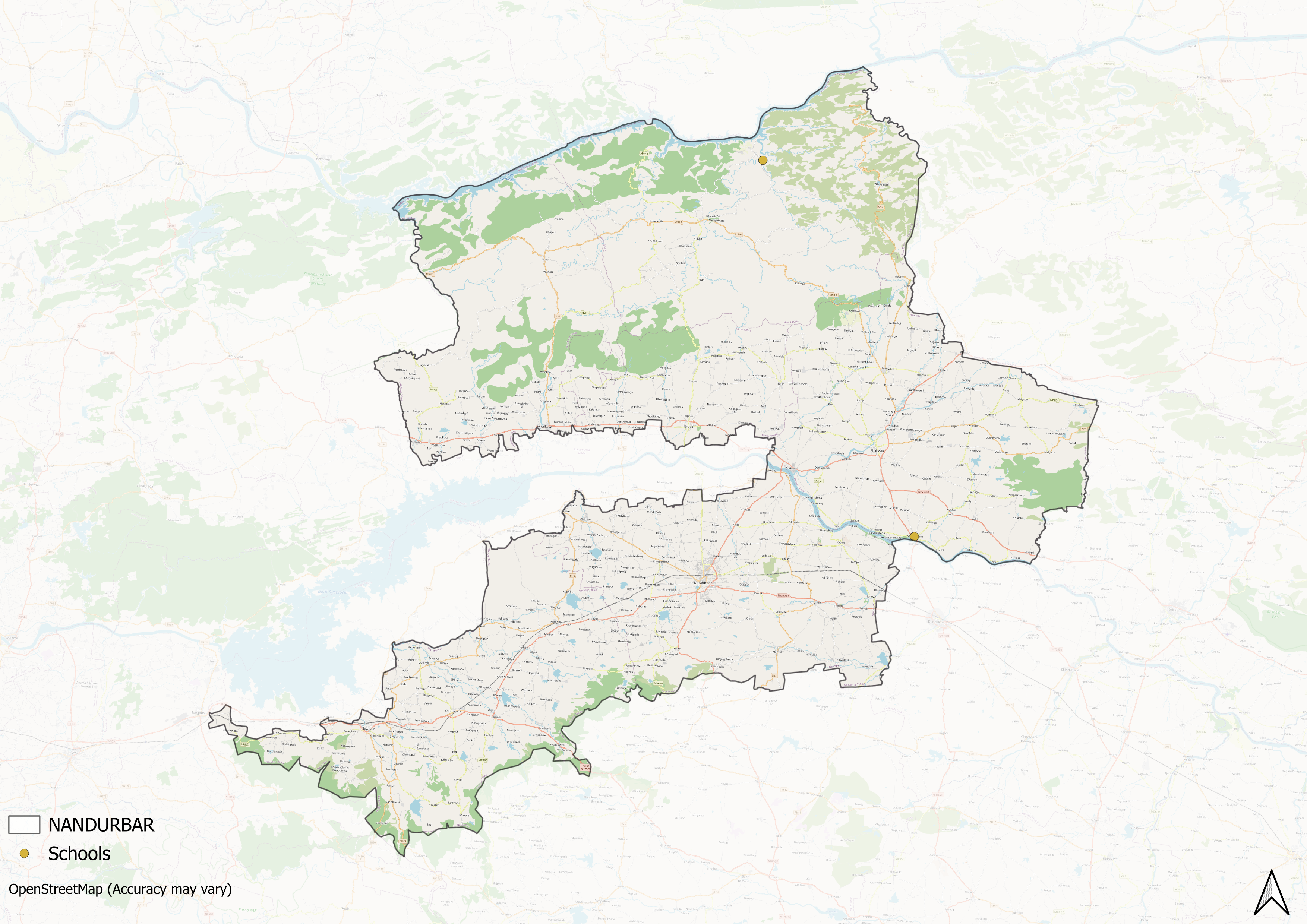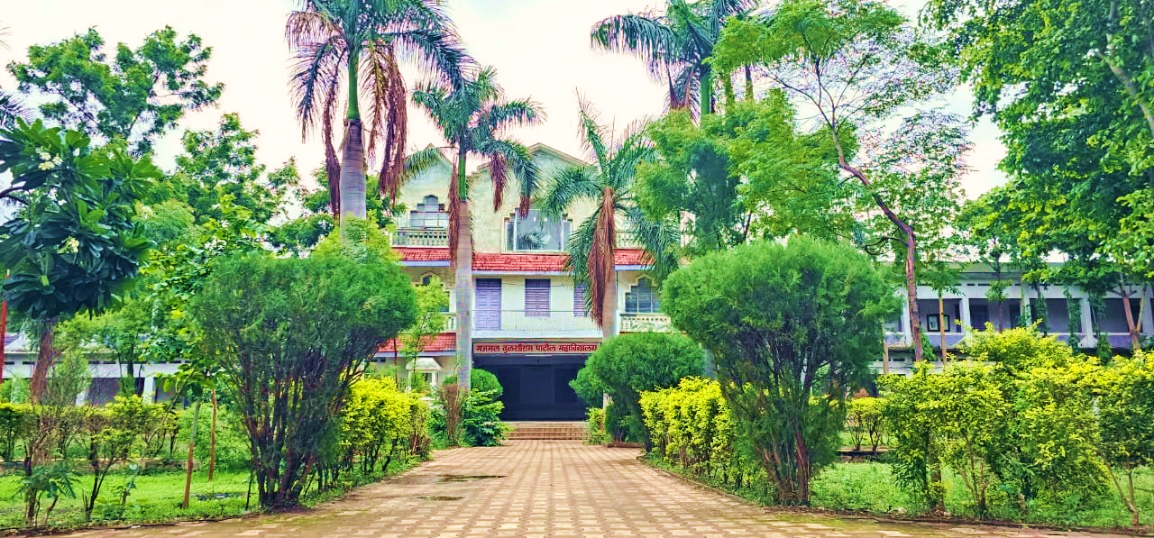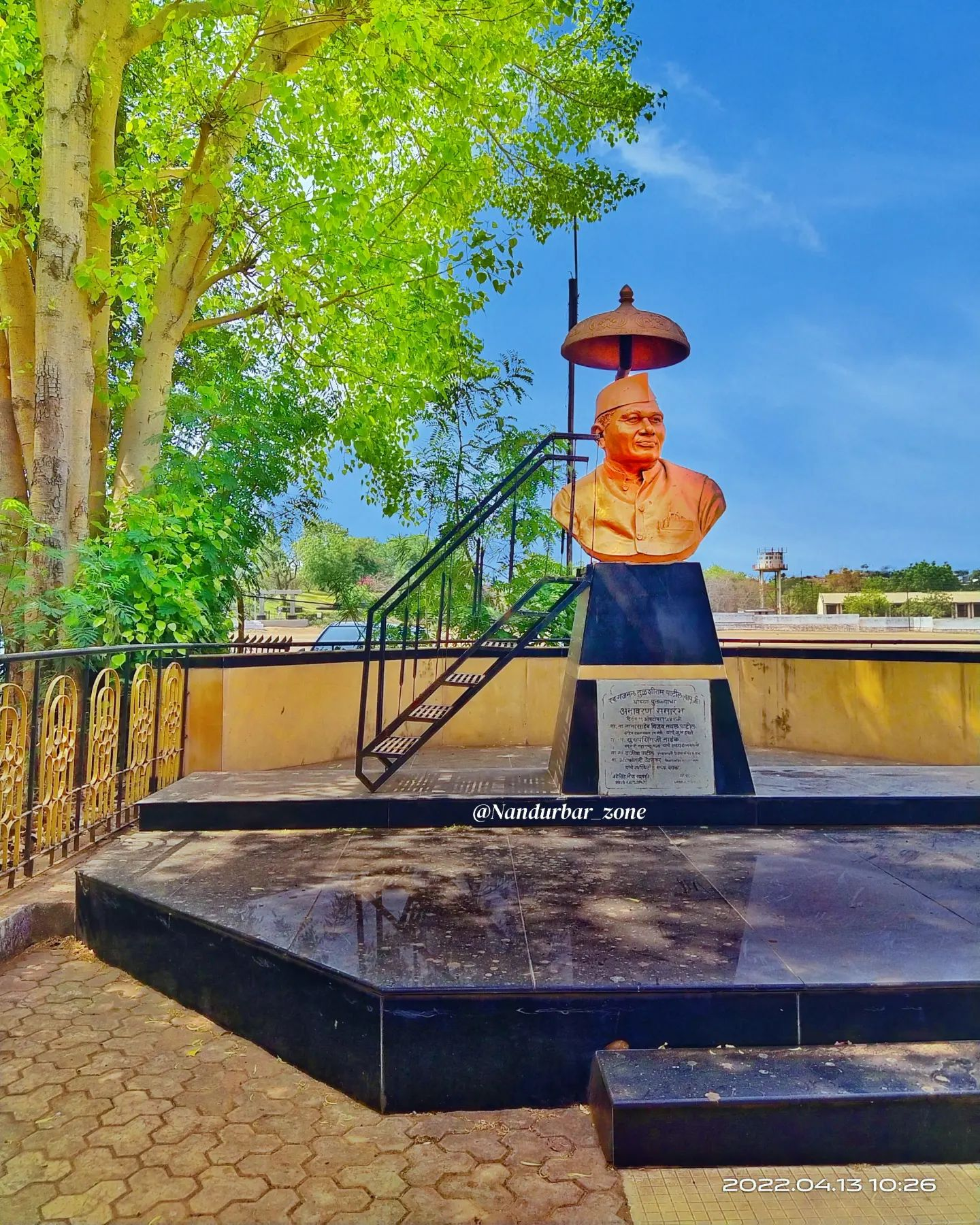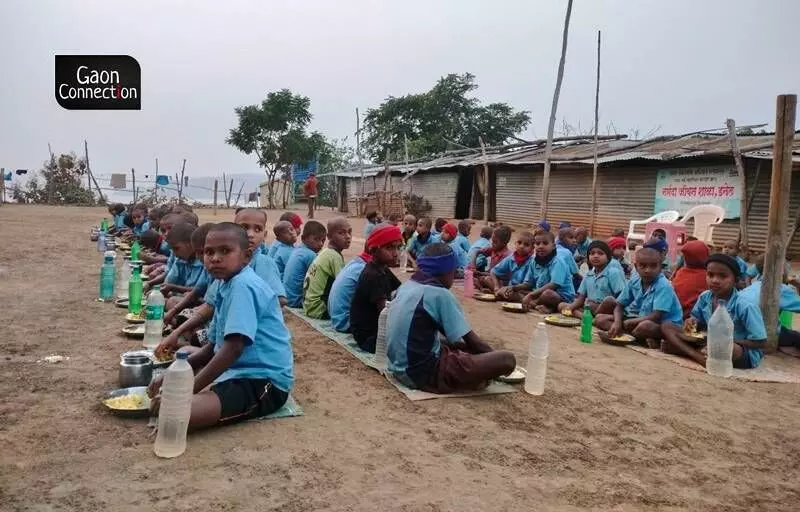Contents
- Early History
- Colonial History
- Post-Independence Era and Contemporary Educational Infrastructure
- Primary & Secondary Education
- Institutions of Higher Learning
- G.T. Patil College
- Jijamata College
- Local Figures & Organizations
- Nandurbar Taluka Vidhayak Samiti
- NGOs and Community-Based Education Efforts
- Jeevan Shalas & Narmada Nav Nirman Abhiyan
- Graphs
- Enrollment and Dropout Rate
- A. Student Enrollment Numbers
- B. Student Enrollment (Class-Wise)
- C. Student Enrollment (Gender-Wise)
- D. Student Enrollment (By School Management Type)
- E. Drop Out Rate (By Schooling Level)
- F. Drop Out Rate (By Gender)
- Schools
- A. No. of Schools
- B. No. of Schools (Filtered by Gender Mix)
- C. No. of Schools (By School Management Type)
- Teachers
- A. No. of Teachers
- B. No. of Teachers (By School Management Type)
- C. No. of Teachers (Male vs Female)
- D. Education Level of Teachers
- Sources
NANDURBAR
Education
Last updated on 28 July 2025. Help us improve the information on this page by clicking on suggest edits or writing to us.
The educational framework of Nandurbar aligns with the broader structure of the Indian education system, encompassing pre-primary, primary, secondary, and higher education. By the 19th century, the introduction of the Western education framework in the district changed its educational landscape. British administrators and missionaries became actively involved in shaping education in the region.
Still, even as colonial influences grew, the early 20th century saw a wave of local initiatives; its existence indicated an increasing public awareness regarding the importance of education. Local communities took charge of education, a movement that carried into the post-independence era, shaping the district’s educational landscape in lasting ways.
Early History
Little is known about the history of education in Nandurbar; however, this does not imply that formal education was completely absent in the district. It is possible that, like many places across Maharashtra, some systems of education did exist in the district in earlier times.
Colonial History
Nandurbar remained administratively under the Dhule district until its eventual separation. Throughout the 19th century, the spread of formal education in the area progressed slowly and unevenly, shaped by the priorities of colonial governance.
The Khandesh District Gazetteer (1882) provides one of the earliest overviews of the educational situation in the region. Between 1847 and 1856, it is noted that one school was established in Nandurbar. By the latter half of the 19th century, the subdivisions of Nandurbar, Chopda, and Taloja were noted as having some of the lowest numbers of village schools in Khandesh, indicating limited outreach and infrastructure. Opportunities for girls' education appear to have been scarce. The only girls’ school mentioned in official records was located at Ranala (which lies in present-day Nandurbar district) and catered specifically to Muslim girls.
In addition to government efforts, missionary institutions contributed to educational initiatives in the region. One such example is the S.A. Mission Primary School, established in 1922 in Nandurbar town. A private aided institution, it has remained part of the district’s educational landscape, providing primary-level education from Grade 1 to Grade 7.
Post-Independence Era and Contemporary Educational Infrastructure
Following India's independence, the education system in Nandurbar underwent major transformations. The introduction of structured education levels: pre-primary, primary, secondary, and higher education, and the implementation of National Education Policies heavily shaped the educational landscape of the district. Over the years, the education sector has developed with contributions from both government-funded institutions and private organizations. Additionally, Educational boards were also introduced, each offering distinct curricula and standards, providing students with more choices.
Primary & Secondary Education
During the colonial period, both public and private efforts in education primarily focused on primary and secondary schooling, as indicated by data from district gazetteers across Maharashtra. Since Independence, education in Nandurbar has expanded gradually, influenced by state-level policies, district reorganisation, and local social factors. When Nandurbar was part of the Dhule district, educational infrastructure remained limited, especially in the Scheduled Tribe, dominated and hilly areas. After the district’s formation in 1998, more targeted efforts were made to address these regional disparities.

Today, this expansion is evident in the widespread presence of schools across various wards of Nandurbar, with available data reflecting the steady growth of educational institutions in both urban and rural parts of the district.
Primary education has largely been provided through Zilla Parishad and Ashram schools (mainly for the ST population), which are spread across all talukas. Marathi has remained the principal medium of instruction, though in several blocks, particularly Akkalkuwa and Akrani, studies by Chattopadhyay and Durdhawale (2009) have cited that the medium of instruction has particularly posed a challenge. In response, some schools have introduced instruction in languages such as Bhili (which is most dominantly spoken there), especially at the early stages of schooling.
Over time, English-medium and private schools have become more common, especially in urban areas such as Nandurbar, Shahada, and Taloda. Most are affiliated with the SSC Board, though a few CBSE schools have been established in recent years. This shift is relatively recent and reflects a broader trend across Maharashtra.
Secondary and higher secondary education is now available in each taluka, though dropout rates are noted to have remained high in interior regions. Despite these challenges, the district has seen an increase in enrolment over the past two decades, supported by schemes such as the Sarva Shiksha Abhiyan and local initiatives.
Institutions of Higher Learning
Perhaps one of the most notable changes in Nandurbar’s educational landscape is tied to the establishment of higher education institutions. While primary and secondary schooling expanded steadily, opportunities for advanced education remained limited for much of the district’s history. Over time, local leaders and organizations played a crucial role in addressing this gap, leading to the creation of several colleges. As a result, many institutions in the district today are privately managed, semi-private, or autonomous.
G.T. Patil College

Established in 1964 by the Nandurbar Taluka Vidhayak Samiti (NTVS), G.T. Patil College was among the first institutions to offer higher education in the district. It was founded under the leadership of Gajamal Tulshiram Patil, a former MLA, along with other local figures, with the aim of extending educational access to students from Adivasi and rural backgrounds. At the time, opportunities for post-secondary education in Nandurbar were limited, especially for marginalized communities.
Initially offering courses in arts and commerce, the college gradually expanded its academic scope to include science and research programmes. It is affiliated with Kavayitri Bahinabai Chaudhari North Maharashtra University, Jalgaon. G.T. Patil College continues to serve as a key higher education institution in the region, particularly for first-generation learners from rural and ST-dominated areas.
Jijamata College
Jijamata College was established in 1986 in Nandurbar by Diliprao Mothabhau More. Initially offering undergraduate courses in Arts, Science, and Commerce, the college later expanded its academic scope to include vocational and professional programmes. These include a B.Ed. college, pharmacy courses, and technical education streams. The institution also houses a Yashwantrao Chavan Maharashtra Open University (YCMOU) study centre, which supports distance education for students unable to attend full-time programmes.


In addition to these institutions, a number of centres for higher education operate throughout the district, which offer programmes across various disciplines. While the landscape of higher education has broadened significantly since independence, disparities in access, particularly along geographic lines, remain evident.
Local Figures & Organizations
Nandurbar Taluka Vidhayak Samiti
Founded in 1961, NTVS is a local educational trust established with the primary goal of improving access to education in ST-dominated and rural areas of Nandurbar taluka. Its first initiative was a residential boarding school for Adivasi children, named after Yashwantrao Chavan, then Chief Minister of Maharashtra. This was followed by the founding of Yashwant High School in 1962 and, subsequently, G.T. Patil College in 1964. These institutions marked a significant shift in the region's educational landscape, where formal schooling options were previously scarce.

Over time, the Samiti expanded its work to include health, environmental, and awareness campaigns. It conducted vaccination drives, tree plantation efforts, and health check-up camps, and contributed to national disaster relief funds. According to recent records, NTVS now manages over 65 institutions, serving more than 20,000 students annually. Its work has played a central role in improving literacy and access to education in the district, particularly among Adivasi communities.
NGOs and Community-Based Education Efforts
Education has been a key driver of social reform, particularly in addressing inequality and expanding access to learning. While formal institutions provide structured education, many communities continue to face barriers due to poverty, social stigma, or lack of resources. To address these challenges, various organizations in Nandurbar have focused on community-based education initiatives, with each working to tackle specific social challenges present in the district.
Jeevan Shalas & Narmada Nav Nirman Abhiyan
The Jeevan Shalas are community-run residential schools established in 1997 to serve children displaced by the construction of the Sardar Sarovar Dam, particularly in the ST-dominated villages of Nandurbar district. These schools emerged as a grassroots response to the severe disruption of education among adivasi communities affected by forced relocation and loss of access to state-supported infrastructure.

Managed and funded by the Narmada Nav Nirman Abhiyan, a Mumbai-based trust, Jeevan Shalas were designed to provide consistent, locally adapted education in areas where government schools were inaccessible or non-functional. As of the late 2010s, four such schools operated across Nandurbar’s remote interiors, often in villages where the nearest government school could be 10 to 15 kilometres away and separated by difficult terrain or the backwaters of the dam.
Functioning as both residential and day schools, Jeevan Shalas aim to maintain continuity in education despite ongoing displacement, environmental hardship, and the absence of basic infrastructure. Nonetheless, the schools have recorded notable success. Graduates have gone on to pursue government employment and, in some cases, leadership roles within their villages.
Graphs
Enrollment and Dropout Rate
Schools
Teachers
Sources
Aparajita Chattopadhyay, Vijaya Durdhawale. 2009. Primary schooling in a tribal district of Maharashtra: Some policy relevance. Journal of Education Administration and Policy Studies Vol.1 no. 5.
Bellwether Nandurbar. “Our Management.” Bellwether Nandurbar.https://bellwethernandurbar.com/index.php/ou…
Government of Maharashtra. 1974. Maharashtra state Gazetteers: Dhulia District. Bombay, Gazetteers Department.https://archive.org/details/dli.ministry.084…
James M Campbell. 1880. Gazetteer Of Bombay Presidency: Khandesh, Vol.12. Government Central Press, Bombay.https://archive.org/details/1880GazetteerOfB…
Jijamata Education Society. “About Us.” Jijamata Education Society.
Jitendra Baisane. 2022. Kasturba Gandhi Balika Vidyalaya in Nandurbar ZP School Surwani. TV9 Marathi.https://www.tv9marathi.com/maharashtra/nandu…
NTVS GTP College. About the Institution.https://ntvsgtpcollege.org/ntvsgtpcollege/ab…
NTVS GTP College. College Website.https://ntvsgtpcollege.org/ntvsgtpcollege/
Rupesh R. Deore, U.V. Nile, Sandip S. Bhavsar, K.L. Pardeshi. 2020-21. “Issues and Challenges of Tribal Higher Education: A Study of Nandurbar District, Maharashtra." Aegaeum Journal.
Sakal News. 2023. India's First Unique Planetary Model in Four Schools in Nandurbar.https://www.esakal.com/uttar-maharashtra/cou…
Satish Malviya. 2023. “Challenges in Educating Adivasi Students in Nandurbar's Remote Areas.” Gaon Connection.https://www.gaonconnection.com/english/nandu…
Schools.org. “S.A. Mission Primary School.” Schools.org.https://schools.org.in/nandurbar/27010119201…
Shantaram Patil. 2024. “Nandurbar ZP Schools Start Today in the District.” Esakal.https://www.esakal.com/uttar-maharashtra/nan…
Sugunam Das. 1962. “A Study on Education Policies.” Boston University Thesis & Dissertations.https://open.bu.edu/bitstream/handle/2144/17…
Last updated on 28 July 2025. Help us improve the information on this page by clicking on suggest edits or writing to us.